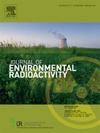重建放射性核素源项的RPAS羽流测量。
IF 2.1
3区 环境科学与生态学
Q3 ENVIRONMENTAL SCIENCES
引用次数: 0
摘要
在放射性事故情况下,最重要的早期关注之一是确定已释放到环境中的放射性物质的数量。这项工作提出了一种通过使用带有机载辐射探测和地理定位传感器包的遥控飞机系统(RPAS)来表征放射性羽流的快速方法。RPAS通过一个研究反应堆Ar-41羽流飞行,RPAS上的伽马光谱仪收集羽流内不同位置的辐射计数和能量,而全球导航卫星系统(GNSS)模块和高度计允许将辐射数据与羽流内的特定位置联系起来。通过将分析高斯羽散模型与羽流数据相结合,对初始释放速率进行了量化。总共进行了30次穿越羽流的实验,结果发现Ar-41释放率与先前计算的估计结果非常吻合。这项工作表明,安装在rpas上的辐射和地理定位传感器包与数学羽流重建技术相结合,能够提供放射性羽流释放率的实时估计。本文章由计算机程序翻译,如有差异,请以英文原文为准。
RPAS plume measurements for reconstructing radionuclide source terms
In radiological accident scenarios, one of the most important early concerns is identifying the quantity of radiological material that has been released to the environment. This work presents a rapid method of characterizing a radioactive plume through the use of a remotely piloted aircraft system (RPAS) with onboard radiation detection and geolocation sensor packages. The RPAS was flown through a research reactor Ar-41 plume, and a gamma spectrometer on board the RPAS collected radiation counts and energies in various locations within the plume, while a Global Navigation Satellite System (GNSS) module and altimeter allowed radiation data to be linked to specific positions within the plume. By combining analytical Gaussian plume dispersion models with data collected from the plume, the initial release rate was quantified. In total, thirty passes through the plume were performed, and the resulting Ar-41 release rates were found to be in good agreement with previously calculated estimates. This work demonstrates that RPAS-mounted radiation and geolocation sensor packages combined with mathematical plume reconstruction techniques are capable of providing real-time estimates of radioactive plume release rates.
求助全文
通过发布文献求助,成功后即可免费获取论文全文。
去求助
来源期刊

Journal of environmental radioactivity
环境科学-环境科学
CiteScore
4.70
自引率
13.00%
发文量
209
审稿时长
73 days
期刊介绍:
The Journal of Environmental Radioactivity provides a coherent international forum for publication of original research or review papers on any aspect of the occurrence of radioactivity in natural systems.
Relevant subject areas range from applications of environmental radionuclides as mechanistic or timescale tracers of natural processes to assessments of the radioecological or radiological effects of ambient radioactivity. Papers deal with naturally occurring nuclides or with those created and released by man through nuclear weapons manufacture and testing, energy production, fuel-cycle technology, etc. Reports on radioactivity in the oceans, sediments, rivers, lakes, groundwaters, soils, atmosphere and all divisions of the biosphere are welcomed, but these should not simply be of a monitoring nature unless the data are particularly innovative.
 求助内容:
求助内容: 应助结果提醒方式:
应助结果提醒方式:


